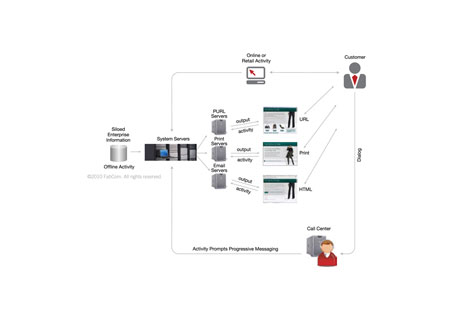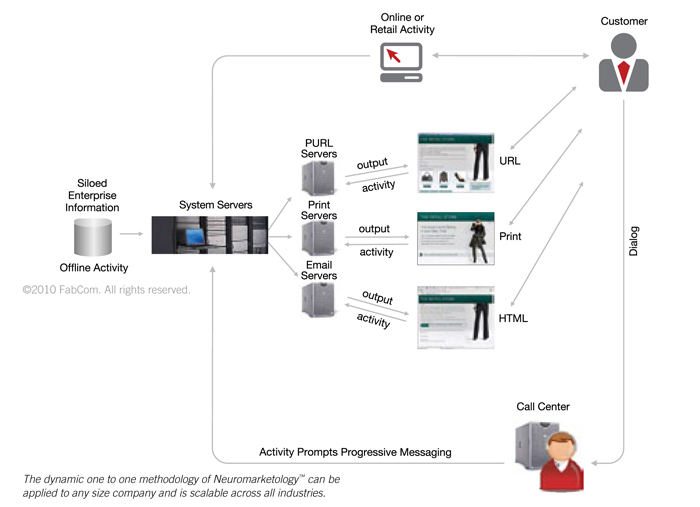
Marketing White Paper
One to One Marketing
One To One Marketing For Everyone – Scalability
SCENARIO:
A small business services company uses 1 to 1 crosschannel marketing to increase contacts and sales at an important annual trade show.
SITUATION:
A small company providing appraisal services to insurance companies and related organizations needed to increase the productivity of their efforts in signing new customer relationships at the industry’s largest annual trade show. In previous years, using only ads in the show program and the same size booth space, they had averaged 10 sales contacts at the show and converted one or two of those to customers each year for more than a decade.
The activity was a challenging but necessary effort and in the worst years, when the new customers did not come through from the show, the effort barely paid for the cost of attending the show. This was tolerated because in the good years, they ended up with three new customers and that would make up for the bad years when only one new customer was signed.
In addition, this was the only show and point of aggregation for this client’s particular niche prospects. The ongoing draw of this show was that it was known as a virtual, “Who’s Who” of the industry, and prospects utilized it heavily when considering a move from a current supplier because they could measure the options and make a choice over a weekend. The upcoming show was causing even greater heartburn for the company owner because the industry, overall, was down 20% from the previous year and his sales were flat compared to the previous period.
SOLUTION:
An automated, cross-media, cross-channel 1 to 1 marketing campaign.
STRATEGY:
We developed a 1 to 1 marketing campaign with interactive online and offline components, using highly personalized marketing vehicles. From the total list of prospective attendees, we targeted just over 500 who mapped to our brand attributes among a list of 1,800 registered attendees prime prospects. We created direct mail to be sent to each prospect before the show, reminding them to come by the booth or hospitality suite and register for a special gift. The creative was personalized to utilize their actual name and information about their attendance at the show as part of the printed graphics on the card.
In addition, on the direct mail piece, we asked the recipient to go to a link that provided a personalized landing page (a Personal URL, or PURL—for example, www.recipientsname.companyname.com) to register to qualify for a new digital music player. The PURL allowed the prospect to register to win one of five free iPods to be given away at the client’s booth at the show. When they registered, they provided their email address and full contact information and the prospects could invite another person attending the show by forwarding the link. The exchange of information allowed us to send email reminders, which also included the hyperlink to the initial recipients and the referred show attendees about the company, the hospitality suite at the show and the free iPods. In addition, the information gleaned from this initial touch was databased and dynamically parsed so that it could be aggregated into campaign No.2.
RESULTS:
From the total universe of 508 targeted prospects, eight (1.6 percent response) visited their PURL and confirmed their information and attendance at the booth from the direct mail touch before the show. Another nineteen (3.7 percent) responded to their HTML and, ultimately, another thirty-three (6.5 percent) showed up at the tradeshow booth with pre-knowledge of the giveaway from a follow-up call that led them to their PURL. These prospects claimed they did not receive the email or direct mail. They were directed to the registration on their PURL, and these prospects printed their registration prior to attending the show or they kept the direct mail card without registering online and presented it at the booth for the iPod (sixty total responders confirmed and provided a tracked response rate of 11.8 percent). The sixty prospects visited the company’s booth at the show as a result of receiving an element of the campaign. Five of the registered prospects who visited the booth were converted to customers within weeks after the show, compared to two conversions per year the previous 10 years. This is 250 percent more in immediate bottom line results. Several other prospects have been converted since the time of the show who attended the show but did not engage at the booth or through the marketing mechanisms. These residual values are also a typical by-product of one to one marketing campaigns. These types of highly personalized dynamic and crosschannel campaigns resonate more than the competitors’ based on the professionalism and reach of the campaign. More importantly, 1 to 1 integrated marketing campaigns also pave the way to penetrate corporate firewalls by inducing first contact online by the target, driven from the offline direct mail message. This implementation methodology induced these corporate prospects to type in the client’s URL natively, placing the client’s URL in the Sent Mail folder and allowing future marketing communications through their corporate spam filters. So, let’s look at this small business ROI. For a 67 percent increasein costs — $10,000 additional costs over the normally invested $15,000 it historically cost the client to attend the show — this client received 250 percent more than the average of two sales at the end of a show they had previously enjoyed with their conventional approach. In addition, it is important to consider the quality of the clients was notably higher; they were bigger companies that spent more per company. This is also an attribute of the more professional projection of image. The attending tradeshow salesperson reported, “The new clients we signed with your campaign were more concerned about what we did well than our price.” Lastly, the data collected on this first initiative will be utilized in future efforts to refine the messaging and future calls to action.
SCALING UP THE RESULTS
If you compare the results of this very small business campaign, it becomes typical when comparing conventional one to many marketing costs and results versus the variable messaging of cross-media, one to one marketing campaign methodology deployed for the client. To imagine how this case study may scale up for you, just add zeros to the end of all the numbers reported. This methodology is truly scalable. It is relying on the personal relevance generated with each potential customer and a database of brand attributes that match your targets’ hierarchy of needs. As long as those matches can be made, the scalability is linear. The client normally invested approximately $15,000 per year including travel, personnel, and booth costs on attending this show. This included mass marketing mailings inserted in the show attendees’ packets and the additional one to many pre-show mailings to the attendees. It is important to note the company’s show marketing efforts had previously included the vendors and competitors that would never purchase or influence the purchase of our client’s services. With our additional marketing expense and refined methodology, the client invested a total cost of $25,000 to attend the show. The additional $10,000 cost of the one to one multichannel personalized campaign garnered 250 percent more for an increased investment of 67 percent.
I chose this example to demonstrate that the company did not have to be large. The company did not have to have state-of-the-art resources to deploy this campaign. They did not have to have data systems that shared information across boundaries. They just had to have the foresight to work with the right partner. A firm that has the resources and the experience to generate one to one, cross-media, cross-channel strategies and the ability to map their brand attributes dynamically, to develop the content to be called upon dynamically and the ability to implement that dynamic and personalized messaging cross-channels—where and when the customers chose.
We work with multibillion dollar firms with universes that include millions of customers in 65 countries across the world. We also have clients who have very limited dollars to invest annually for marketing. The methodology is scalable across industries, customer segments and any media channels.
Let’s not forget what marketing is all about in the first place—customers want to know: “Is this product or service right for me?” We must keep in mind the customer will choose when and where you will be allowed to present your case. This new methodology allows you to accommodate the shift in the markets at astonishing rates of effectiveness, no matter what the message and to whom.

We have seen how the methodology of Neuromarketology™ is applied to online and direct mail consumers to supplement sales. We have looked at how it is applied in the small business-to-business world in new business development activity.
Now, let’s also take a look at how this methodology applies in a larger retail organization driving incremental or additional sales from existing clients. This example is a typical 80/20 revenue growth strategy. Eighty percent of this company’s over $1 billion in sales were from 20% of its customers.
SCENARIO:
This example is a clothing retailer with a deeply developed online presence and a goal of increasing its sales from its online division. The goal was to concentrate a strategy on the 20% of customers that made up the 80% of sales.
TACTICS:
A frequent buyer program was developed that targeted multiple buyers by sending a printed invitation and thank you card with an offer of a free personal shopper program if they registered via a PURL printed on an unsolicited personal shopper invitation. The offer noted that the personal shopper program would automatically consider their likes and dislikes and offer recommendations based on their purchases as well as an additional discount on matching purchases. The invitation was sent additionally by HTML with the same information and same PURL call to action.
Once the customer registered via the PURL and offered additional information with the completion of a simple profile, the customer was now eligible for the additional discounts on following purchases. We then mapped each additional purchase with like items based on brand, color and type of purchase.
Upon purchase, a trigger would match the purchase with like matching products. If someone bought, let’s say, a pair of shoes, we would offer the pants or handbag that would best match the initial purchase, based on their frequent purchaser profile.
RESULTS:
Purchases within this targeted group increased by 21.2% creating an overall sales increase for the year of 8%. Imagine the impact on sales and marketing ROI when thousands of these scenarios play out automatically each day with every one individually timed and dynamically personalized by the system, based on the customer’s own activity. It’s not hard to see that this real-time, individualized and highly relevant conversation with customers can increase sales as well as customer satisfaction.